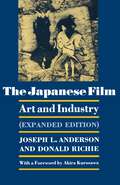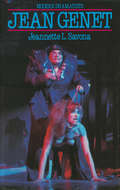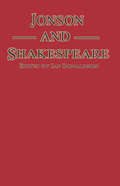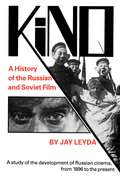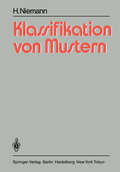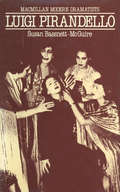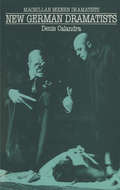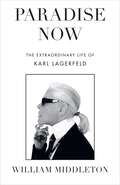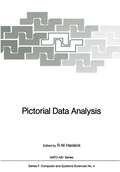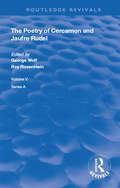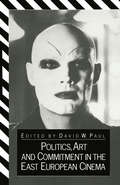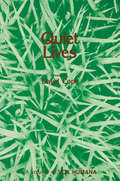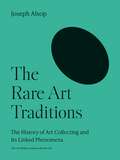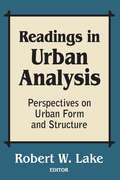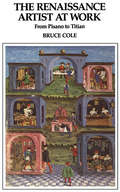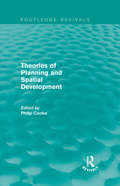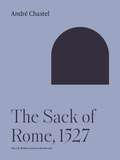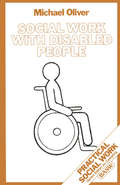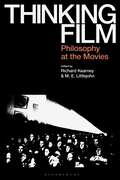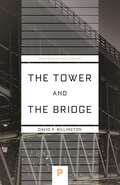- Table View
- List View
The Japanese Film: Art and Industry - Expanded Edition (PDF)
by Donald Richie Joseph L. AndersonTracing the development of the Japanese cinema from 1896 (when the first Kinetoscope was imported) through the golden ages of film in Japan up to today, this work reveals the once flourishing film industry and the continuing unique art of the Japanese film. Now back in print with updated sections, major revaluations, a comprehensive international bibliography, and an exceptional collection of 168 stills ranging over eight decades, this book remains the unchallenged reference for all who seek a broad understanding of the aesthetic, historical, and economic elements of motion pictures from Japan.
Kino: A History of the Russian and Soviet Film, With a New Postscript and a Filmography Brought up to the Present
by Jay LeydaThis history of the turbulent destiny of Kino ("film" in Russian) documents the artistic development of the Russian and Soviet cinema and traces its growth from 1896 to the death of Sergei Eisenstein in 1948. The new Postscript surveys the directions taken by Soviet cinema since the end of World War II. Beginning with the Lumiere filming of the coronation of Tsar Nicholas II, Jay Leyda links Russia's pre-Revolutionary past with its Communist present through the observation of a major cultural phenomenon: the evolution of the Soviet film as an artistic and political instrument. The book contains 150 drawings and photographs and five appendices, including a list of selected Russian and Soviet films from 1907 to the present.
Local Plans in British Land Use Planning: Urban and Regional Planning Series
by Patsy HealeyLocal Plans in British Land Use Planning provides an analysis of the nature, purpose, and operation of development plans in British planning practice. Comprised of 10 chapters, the book discusses about the use of development plans as procedural tools used by government agencies as an element in programs for intervening in the way a land is used and developed. Chapter 1 discusses land policy, land use planning, and development plans, while Chapter 2 covers the British land policy and land use planning. Chapter 3 and 4 tackle structure and local plans, respectively. The fifth chapter attempts to answer the question “Why prepare a local plan?" and the next three chapters tackle local plan production, form and content, and use. Chapter 9 covers the need of explanation regarding the planning system, and Chapter 10 discusses the recommendation to tackle the issues of the British planning system. The book will be of great interest to readers who are curious about the British planning system and in the analysis of public programs.
Meaning in the Visual Arts
by Erwin PanofskySince its original publication, Erwin Panofsky's Meaning in the Visual Arts has been standard reading for students of art history. It is both an introduction to the study of art and, for those with more specialized interests, a profound discussion of art and life in the Middle Ages and Renaissance. Panofsky's historical technique reveals an abundance of detail, detail he skillfully relates to the life and work of individual painters and their times. The papers in this volume represent a cross-section of Panofsky's major work. Included are selections from his well-known Studies in Iconology and The Life and Art of Albrecht Dürer, plus an introduction and an epilogue—"The History of Art as a Humanistic Discipline" and "Three Decades of Art History in the United States: Impressions of a Transplanted European"—as well as pieces written especially for this collection. All display Panofsky's vast erudition and deep commitment to a humanistic conception of art and art history.
New German Dramatists: A Study of Peter Handke, Franz Xaver Kroetz, Rainer Werner Fassbinder, Heiner Müller, Thomas Brasch, Thomas Bernhard and Botho Strauss
by D. CalandraParadise Now: The Extraordinary Life of Karl Lagerfeld
by William Middleton'A deep knowledge of and feeling for his subject' Sunday TimesKarl Lagerfeld, Chanel's iconic Creative Director for thirty-five years, was a cultural luminary like no other. Larger than life, Lagerfeld was legendary not only for reinventing Chanel but also for his idiosyncratic personal style and captivating life, which featured a cast of the world's most famous, fabulous and fascinating people. Not least his cat, Choupette, who herself became a fashion icon.Journalist and author William Middleton spent years working in Paris for Women's Wear Daily, W, and Harper's Bazaar. During his time there, he interviewed and socialized with Lagerfeld, coming to to see a side the elusive designer kept private from the world.In this deliciously entertaining book, Middleton takes us inside the most exclusive rooms in the fashion industry, behind the catwalk, and into a world of brilliantly talented artists, stylish socialites, and famous stars-some of the most elusive and unforgettable figures of fashion's inner circle for the past four decades.
Pictorial Data Analysis (NATO ASI Subseries F: #4)
by Robert M. HaralickThis volume is the collection of lectures and presentations of the NATO AS! On Pictorial Data Analysis, held August 1-12, 1982 in the beautiful chateau de Bonas, Bonas France. The director of the AS! was Robert M. Haralick and the Co-director was Stefano Levialdi. The papers in the book are arranged in two sections first theory and general prinicples and then applications. Local computations play a central role in image processing both when a traditional computer is used and when parallel machines are used for improving image throughput. Levialdi reviews such neighborhood operators. Hung and Kasvand discuss a line thinning application which involves detection of critical points on chain encoded data. Most low level image processing has been done using the digital raster as the basic data structure. Within the last few years many of these basic algorithms have been developed for the quadtree data structure. The quadtree permits easier access to certain kinds of spatial adjacency relationships in a variable resolution context. Rosenfeld reviews the properties of these representations and their uses in image segmentation and property measurement. Besslich discusses an expanded form of an invertible quadtree representation which permits a multiprocessor execution. Gisolfi and Vitulano discuss the C-matrix and C-filtering technique for image and texture feature extraction. O'mara et.al. discuss the application of Codel numbers to image feature extraction. Kropatsch discusses an image segmentation technique which permits the effective use of a variety of different kinds of segmentation techniques.
The Poetry of Cercamon and Jaufre Rudel (Routledge Revivals)
by George Wolf and Roy RosensteinPublished in 1983, Wolf and Rosenstein have delved into the poetry writings in detail of Cercamon and Jaufre Rudel, with detailed textual notes on the poems, exploring the individual poets' lives and looking at the translation of the writings.
The Poetry of Cercamon and Jaufre Rudel (Routledge Revivals)
by George Wolf Roy RosensteinPublished in 1983, Wolf and Rosenstein have delved into the poetry writings in detail of Cercamon and Jaufre Rudel, with detailed textual notes on the poems, exploring the individual poets' lives and looking at the translation of the writings.
Quiet Lives (Vox Humana)
by David CopeI have been much absorbed in David Cope's poetry as necessary continuation of tradition of lucid grounded sane objectivism in poetry following the visually solid practice of Charles Reznikoff & William Carlos Williams. Though the notions of 'objectivism' were common for many decades among U. S. poets, there is not a great body of direct-sighted "close to the nose" examples of poems that hit a certain ideal objectivist mark-"No ideas but in things" consisting of "minute particulars" in which "the natural object is always the adequate symbol", works of language wherein "the mind is clamped down on objects", and where these "Things are symbols of themselves. " The poets I named above specialized in this refined experiment, and Pound touched on the subject as did Zukofsky and Bunting, and lesser but inter esting figures such as Marsden Hartley in his little known poetry , and more romantic writers such as D. H. Lawrence. In this area of phanopoeiac "focus," the sketching of particulars by which a motif is recognizably significant, David Cope has made, by the beginning of his third decade, the largest body of such work that I know of among poets of his own generation. Allen Ginsberg Table of Contents Foreword, Allen Ginsberg. . . . . . . . . . . . . . . . . . . . . . . . . . . . . . . . v THE STARS The Line-up. . . . . . . . . . . . . . . . . . . . . . . . . . . . . . . . 2 . . . . . . . . . . . . Empty Street . . . . . . . . . . . . . . . . . . . . . . . . . . . . . . . . . . . . . . . . . . . 3 The River. . . . . . . . . . . . . . . . . . . . . . . . . . . . . . . . . . . . . . . . . . . . . . 4 Down on the Farm . . . . . . . . . . . . . . . . . . . . . . . . . . . . . . . . . . . . . . 5 The Storm. . . . . . . . . . . . . . . . . . . . . . . . . . . . . . . . . . . . . . . . . . . . . 6 American Dream. . . . . . . . . . . . . . . . . . . . . . . . . . . . . . 7 . . . . . . . . . . Baseball. . . . . . . . . . . . . . . . . . . . . . . . . . . . . . . . . . . 8 . . . . . . . . . . . . Crash. . . . . . . . . . . . . . . . . . . . . . . . . . . . . . . . . . . . . . . . . . . . . . . . 9 . Lunch Hour. . . . . . . . . . . . . . . . . . . . . . . . . 9 . . . . . . . . . . . . . . . . . . . Winter Camp. . . . . . . . . . . . . . . . . . . . . . . . . . 10 . . . . . . . . . . . . . . . . . A Circle of Lights . . . . . . . . . . . . . . . . . . . . . . . . . . . . 12 . . . . . . . . . . GO Labor Day . . . . . . . . . . . . . . . . . . . . . . . . . . . . . . . . . . 14 . . . . . . . . . . . Peace. . . . . . . . . . . . . . . . . . . . . . . . . . . . . . . . . . . . 15 . . . . . . . . . . . . .
The Rare Art Traditions: The History of Art Collecting and Its Linked Phenomena (The A. W. Mellon Lectures in the Fine Arts #27)
by Joseph AlsopA cultural and social history of art collecting, art history, and the art marketIn The Rare Art Traditions, Joseph Alsop offers a wide-ranging cultural and social history of art collecting, art history, and the art market. He argues that art collecting is the basic element in a remarkably complex and historically rare behavioral system, which includes the historical study of art, the market for buying and selling art, museums, forgery, and the astonishing prices commanded by some works of art. The Rare Art Traditions tells the story of three important traditions of art collecting: the classical tradition that began in Greece, the Chinese tradition, and the Western tradition. The result is a major original contribution to art history.
Readings in Urban Analysis: Perspectives on Urban Form and Structure
by Robert W. LakeThis important work brings together a range of perspectives in contemporary urban analysis. The field of urban analysis is characterized by the multiplicity of approaches, philosophies, and methodologies employed in the examination of urban structure and urban problems. This fragmentation of perspectives is not simply a reflection of the multifaceted and complex nature of the city as subject matter. Nor is it a function of the variety of disciplines such as geography, planning, economics, history, and sociology. Cross-cutting all of these issues and allegiances has been the emergence in recent years of a debate on fundamental issues of philosophy, ideology, and basic assumptions underlying the analysis of urban form and structure. The notion of urban analysis Robert W. Lake discusses focuses on the spatial structure of the city, its causes, and its consequences. At issue is the city as a spatial fact: a built environment with explicit characteristics and spatial dimensions, a spatial distribution of population and land uses, a nexus of locational decisions, an interconnected system of locational advantages and disadvantages, amenities and dis-amenities. Beginning with landmark articles in neo-classical and ecological theory, the reader covers the latest departures and developments. Separate sections cover political approaches to locational conflict, institutional influences on urban form, and recent Marxist approaches to urban analysis. Among the topics included are community strategies in locational conflict, the political economy of place, the role of government and the courts, institutional influences in the housing market, and the relationship between urban form and capitalist development. This is a valuable introductory text for courses in urban planning, urban geography, and urban sociology.
Readings in Urban Analysis: Perspectives on Urban Form and Structure
by Robert W. LakeThis important work brings together a range of perspectives in contemporary urban analysis. The field of urban analysis is characterized by the multiplicity of approaches, philosophies, and methodologies employed in the examination of urban structure and urban problems. This fragmentation of perspectives is not simply a reflection of the multifaceted and complex nature of the city as subject matter. Nor is it a function of the variety of disciplines such as geography, planning, economics, history, and sociology. Cross-cutting all of these issues and allegiances has been the emergence in recent years of a debate on fundamental issues of philosophy, ideology, and basic assumptions underlying the analysis of urban form and structure. The notion of urban analysis Robert W. Lake discusses focuses on the spatial structure of the city, its causes, and its consequences. At issue is the city as a spatial fact: a built environment with explicit characteristics and spatial dimensions, a spatial distribution of population and land uses, a nexus of locational decisions, an interconnected system of locational advantages and disadvantages, amenities and dis-amenities. Beginning with landmark articles in neo-classical and ecological theory, the reader covers the latest departures and developments. Separate sections cover political approaches to locational conflict, institutional influences on urban form, and recent Marxist approaches to urban analysis. Among the topics included are community strategies in locational conflict, the political economy of place, the role of government and the courts, institutional influences in the housing market, and the relationship between urban form and capitalist development. This is a valuable introductory text for courses in urban planning, urban geography, and urban sociology.
The Renaissance Artist At Work: From Pisano To Titian (Icon Editions Ser.)
by Bruce ColeThis book gives the necessary background for the study and appreciation of Italian painting and sculpture from about 1250 to 1550. It tells how the artists learned their craft, the organization of their workshops, and the guilds they belonged to; how their customers or patrons treated them and where their work was displayed?churches, civic buildings, or private homes. The book discusses how art was made?tempera, oil, panel, canvas, fresco; it surveys the characteristic types of Renaissance art?altarpieces, portraits, tombs, busts, doors fountains, medals, etc.
Routledge Revivals: Theories of Planning and Spatial Development (Routledge Revivals)
by Philip CookeFirst published in 1983, this book attempts to unify two bodies of theory which had become severely disjointed. Theories of the planning process had become detached from those of the urban and regional processes which are the subject of planning intervention. The author argues that major weaknesses of planning intervention in cities and regions have resulted from this split, and shows how it is possible to develop an integrated theory of the relationship between planning and spatial development. The mechanism which helps to unify the two fields is the division of labour. This poses problems for the planning system as its spatial requirements change but it depends upon the state planning framework in order to overcome those obstacles — hindering its capacity for spatial reorganisation. This book offers a thorough analysis of these obstacles and requirements by references to contemporaneous theoretical advances in the study of the development process, the state (especially at sub-national level), and the labour market. It is argued that the way capital makes use of urban and regional space can be explained by using the theoretical framework which is developed and, on this basis, point to certain innovative ways in which the processes underlying urban and regional de-industrialisation may be countered.
Routledge Revivals: Theories of Planning and Spatial Development (Routledge Revivals)
by Philip CookeFirst published in 1983, this book attempts to unify two bodies of theory which had become severely disjointed. Theories of the planning process had become detached from those of the urban and regional processes which are the subject of planning intervention. The author argues that major weaknesses of planning intervention in cities and regions have resulted from this split, and shows how it is possible to develop an integrated theory of the relationship between planning and spatial development. The mechanism which helps to unify the two fields is the division of labour. This poses problems for the planning system as its spatial requirements change but it depends upon the state planning framework in order to overcome those obstacles — hindering its capacity for spatial reorganisation. This book offers a thorough analysis of these obstacles and requirements by references to contemporaneous theoretical advances in the study of the development process, the state (especially at sub-national level), and the labour market. It is argued that the way capital makes use of urban and regional space can be explained by using the theoretical framework which is developed and, on this basis, point to certain innovative ways in which the processes underlying urban and regional de-industrialisation may be countered.
The Sack of Rome, 1527 (The A. W. Mellon Lectures in the Fine Arts #26)
by André ChastelFrom a leading art historian of Renaissance Italy, a compelling account of the artistic and cultural impact of the sack of sixteenth-century RomeIn this illustrated account of the sack of Rome as a cultural and artistic phenomenon, André Chastel reveals the historical ambiguities of preceding events and the traumatic contrast between the flourishing world of art under Pope Clement VII and the city after it was looted by the troops of Emperor Charles V in 1527. Chastel illuminates the cultural repercussions of the humiliation of Rome, emphasizing the spread or “Europeanization” of the Mannerist style by artists who fled the city—including Parmigianino, Rosso, Polidoro, Peruzzi, and Perino del Vaga. At the same time, Clement’s critics used the new media of printing and engraving to win over the people with caricatures and satirical writings, while Rome responded with monumental works affirming the legitimacy of the pope’s temporal power. Chastel explores both the world that was lost by the sack and the great works of art created during Rome’s recovery.
Social Work with Disabled People (Practical Social Work Series)
by Michael OliverThis book has been substantially revised to take into account the legislative changes since 1983 and the theoretical developments in the field of disability. Whilst continuing to highlight the negative impact of welfare policy on the lives of disabled people, it develops arguments as to how social work can contribute to the removal of disabling barriers and looks at the implications that an anti - disablist practice would have for the education and training of social workers and the management of welfare agencies.
Thinking Film: Philosophy at the Movies
by Richard Kearney and M. E. LittlejohnHailed as one of America's original art forms, film has the distinctive character of crossing high and low art. But film has done more than this. According to American philosopher Stanley Cavell, film was also a place where America in the 1930s and 1940s did its thinking, a tradition that was taken up and enriched throughout world cinema. Can film indeed think? That is, can film do the work of philosophy?Following Cavell's lead to think along the tear of the analytic-continental traditions, this book draws from both sides of the philosophical divide to reflect on this question. Spanning generations and disciplines, pondering everything from art house classics to mainstream blockbusters, Thinking Film: Philosophy at the Movies aims to fling open the doors to this conversation on all sides. Inquiring into both philosophy's word on film and film's word to philosophy, the interdisciplinary dialogue of this book traverses the conceptual and the particular as it considers how film catalyzes our thinking and sets us talking. After viewing the world through film, we find our world--and ourselves--transformed by deeper understanding and new possibilities.This book aims to provide a novel and engaging way in to thinking with and about this enduringly popular art form.
The Tower and the Bridge: The New Art of Structural Engineering (Princeton Science Library #130)
by David P. BillingtonAn essential exploration of the engineering aesthetics of celebrated structures from long-span bridges to high-rise buildingsWhat do structures such as the Eiffel Tower, the Brooklyn Bridge, and the concrete roofs of Pier Luigi Nervi have in common? According to The Tower and the Bridge, all are striking examples of structural art, an exciting area distinct from either architecture or machine design. Aided by stunning photographs, David Billington discusses the technical concerns and artistic principles underpinning the well-known projects of leading structural engineer-artists, including Othmar Ammann, Félix Candela, Gustave Eiffel, Fazlur Khan, Robert Maillart, John Roebling, and many others. A classic work, The Tower and the Bridge introduces readers to the fundamental aesthetics of engineering.
